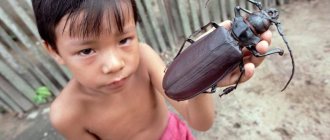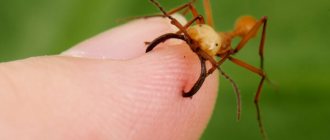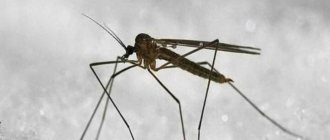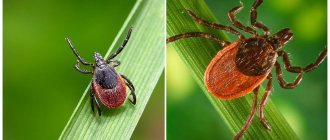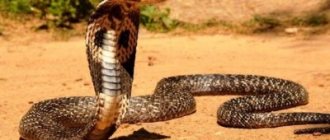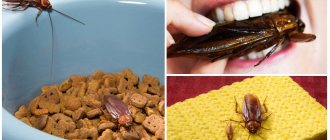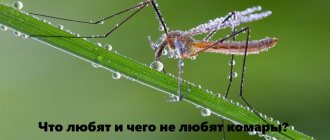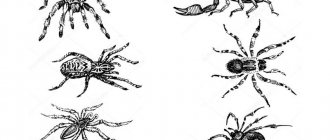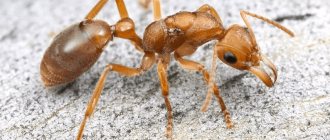Ecology
Our planet is home to a great variety of living creatures that are dangerous to humans, and they do not necessarily have to be large in size. Insects can cause a lot of harm. Insects have played an important role throughout history, they were mentioned in the Bible, and they were found in the graves of ancient Egyptians. They also appear in many literary works. However, insects do not particularly attract the attention of most of us, and some are even afraid of them, which is quite reasonable, given the not so pleasant characteristics of these creatures. There are very safe insects, but today we will talk about those that pose a particular threat and from which it is better to stay away.
Fourth place - gadflies and horse flies
Horsefly and gadfly
In addition to the severe pain from a bite of a horsefly or gadfly, there is a risk of infection - insects even carry anthrax. There is a risk of subcutaneous introduction of gadfly larvae - this is how they reproduce. Horseflies do not lay larvae on their victims. The larva may even end up in the eye or inside the skull. Laying eggs on the body of the victim is not at all necessary; insects can lay them on the grass, where they develop until they move onto the body of the host, usually a herbivore.
Interesting: How do insects breathe? Description, photo and video
Gadflies are attached to a specific host species - for example, there are sheep, cow gadflies, and other varieties. But none of them will refuse to bite a person or lay a larva. Insects migrate with herds and are active in farmyards and near water.
Bullet Ant
If a bullet ant or diurnal ant makes a cry, it means it is ready to attack its prey. One of the most dangerous insects lives on a tree, where it grows its anthill, the height of which can be more than 10 meters. This species is common in South America and is distinguished by a powerful sting and paralyzing venom. The bullet ant is a predator. It feeds on both living and dead insects, but also loves sweet plant juice. He is considered a peaceful inhabitant of the tropics until danger threatens. If you have to defend yourself, the ant will first make a warning hissing sound, emit an unpleasant odor, and only then attack. Its bite is so painful that it is comparable to a bullet wound. Hence the name "bullet". And the pain experienced by the bitten person lasts a day, which gave the second name “daily” or “24 hours”.
 Bees
Bees
Some types of bees are not as harmless as they might seem. For example, the African bee and its hybrids, which appeared in America as invasive species, are quite aggressive and have caused a lot of damage over the past 50 years. Regular bees are known not to take up arms unless necessary, and they die after being stung. A bee sting itself is not fatal, but it can cause allergic reactions and anaphylactic shock, which leads to death. Unlike ordinary bees, killer bees can attack even in the case of the slightest provocation, and attack the victim in a whole swarm. These bees kill people and livestock.
1) Poisonous caterpillar Lonomiya
In appearance, a completely ordinary caterpillar, Lonomia, does not look so terrifying at all. But in fact, it is the deadliest caterpillar in nature. Initially, scientists assumed that touching it could cause normal skin irritation and burns, but in the end it would be much worse. Its poison kills a considerable number of people every year. The caterpillar itself is just an ordinary larva of the Saturnia butterfly from the Peacock Eye family. The main habitat of the caterpillar is the tropical expanses of South America, Brazil, Paraguay and Argentina. Externally, lonomia is found in brown or green color. Her body is covered with furry growths that contain poison. A person touching a caterpillar gets his skin pierced by its thorny fibers. Then, at the moment of puncture, it leaves a drop of poison, which enters the person’s bloodstream. A slight pain appears at the puncture site, which recedes after a while. The effectiveness of the poison does not act immediately, but after a little time. The toxic poison of lonomy causes further consequences such as: cerebral hemorrhage, kidney failure, poisoning of the body and blocks blood clotting. Also, after a puncture, when the pain subsides, you can notice huge hemorrhages on the body, which indicate poisoning. An antidote to the toxic venom of this caterpillar exists, but it must be administered immediately within 24 hours. There are often cases when a person does not even feel the attack of lonomia. After all, this caterpillar has good camouflage, which makes it invisible against the background of tree bark and leaves.
4) Wasps
Wasps are known to many people all over the world. These social insects with a bright yellow body and long antennae hunt parasites and pests, with each individual subspecies having its own prey. However, a wasp sting can be very dangerous for humans, as it is very painful and often causes allergic reactions. Some stung people go into anaphylactic shock and can die from just one wasp sting.
5) Scorpios
These representatives of arthropods – scorpions – pose no small danger. These arachnid creatures number more than 2,450 species in their family. But out of a huge crowd of varieties, only 25 are deadly poisonous. Among them there are large specimens of 20-21 centimeters and very small ones reaching a maximum size of 12-13 mm. Scorpions are one of the oldest creatures on the planet, and are also not inferior in toxicity to spiders and snakes. Scorpions sometimes attack people by creeping in unnoticed from the back or side. They have very developed vision and therefore in most cases do not approach the victim directly. When I attack its prey, the scorpion thrusts its sting and injects poison. Possessors of a less toxic poison may cause the following symptoms: temporary fever, chills, temperature, headaches, swelling, burning at the injection site, nausea and lethargy. But poisonous representatives cause the following symptoms: dizziness, impaired consciousness, convulsions, tachycardia, asphyxia and sudden changes in pressure. In more severe cases: blood poisoning, paralysis, epilepsy, coma and death.
Earwig
0
While drying your clothes on a clothesline may initially seem like a great idea, be prepared to find these small insects in your dry clothes when you remove them. One of the horror stories associated with this insect tells that earwigs like to penetrate the human brain at night through the ear. Fortunately, this annoying myth has been debunked.
Insects dangerous to humans
These insects surround humans everywhere. They bite painfully, release toxic substances, drink blood, and carry diseases and parasites.
Russia is home to many poisonous insects that can cause serious harm to humans.
Fleas
When bitten, a dangerous infection such as plague or typhus can be introduced into the body. There are five types of fleas in Russia:
- human;
- canine;
- feline;
- rabbit;
- rat.
Types of fleas
Fleas carry the pathogens of salmonellosis, pasteurellosis, brucellosis, hepatitis B and C, and tularemia. When bitten, saliva is released, which causes burning and itching.
Horseflies
Large and fleshy biting flies that actively attack people and animals and feed on their blood. Females prefer to bite wild and domestic mammals, but if there is no choice, they can begin to attack people.
At one time, a female horsefly sucks approximately 200 mg of blood. After drinking the blood of an animal, the insect becomes a carrier of dangerous infectious diseases, which can also be transmitted to humans.
Horseflies pose a danger to both humans and cattle
When bitten, a horsefly releases toxic saliva into the bloodstream, which causes severe itching on the skin. If you have an allergy, anaphylactic shock may occur.
The bite of a horsefly is one of the most painful among insects. They have a sharp proboscis, whose structure resembles a surgical scalpel.
Autumn burner
A small fly measuring up to 7 mm with a stocky gray body. They are blood-sucking insects that actively attack humans and domestic animals. It can often be seen in places where cattle gather. Carries tularemia and anthrax. Found in all geographic regions of the world.
The bite of a live fly is dangerous due to the entry of pathogenic microorganisms into the blood
Bed bug
These insects live in crowded places and feed on human blood at night, hiding in the nooks of the home during the day. Body length – from 3 to 8.4 mm. Color ranges from dirty yellow to dark brown. There are three types of house bugs:
- cimex lectularius - occurs most often, has a specific odor, loves the blood of children due to the close proximity of the vessels to the skin;
- cimex pipistrelli - drink the blood of bats;
- oeciacus hirundinis – sucks blood from birds, transmits pathogens.
Bedbugs sneak into people's beds, bite through the skin and suck blood, causing serious discomfort and leaving red marks on the skin.
Bedbugs are dangerous blood-sucking parasites; their bites can cause an allergic reaction.
A bug bite mark causes itching, irritation, and a rash. They can introduce infection into the human body. Getting rid of bedbugs is not very easy.
Lice
Small wingless insects that parasitize the scalp, body or pubic hair of a person and suck blood from it. The infestation of lice causes a skin lesion called pediculosis.
Parasites that settle on the hairline leave grayish eggs behind the ears and on the back of the head. Body lice carry vector-borne diseases, and head lice cause relapsing fever. Sometimes they provoke pustular diseases.
Lice are wingless parasitic insects that feed on human blood.
Mosquitoes
Blood-sucking insects that dig into the human body with their proboscis. There is slight redness and itching at the site of the bite. Through their bites they transmit many dangerous diseases. In the evening they become much more active.
The list of diseases carried by mosquitoes includes encephalitis, malaria, and yellow fever, from which millions of people die every year.
Mosquitoes, in addition to painful bites, can carry various infectious diseases
In total, there are about 40 bacterial, viral and parasitic infections caused by mosquitoes.
Calyptra cornflower
A moth butterfly that feeds on the blood of living creatures. By piercing the skin with its proboscis, it can become saturated with human blood within 20 minutes. The bloodsuckers of this species are males, while females are busy collecting nectar. This species of butterfly is nocturnal.
Calyptra basilfolia is a night butterfly that feeds on the blood of living creatures.
Gadflies
The insect belongs to the order Diptera. There are about a dozen varieties of gadflies in total. They are generally named after the animals they tend to parasitize. There are horse, sheep, and subcutaneous gadflies. The cavitary botfly parasitizes humans, clinging to the internal cavities of the nose and eye folds.
Gadflies lay larvae in the body of mammals. The insect looks like a large, hairy fly, reaching one and a half centimeters in length. These are carriers of dangerous pathogens.
There have been cases when insects stung a person directly in the eye, causing him to become blind.
The gadfly is a large fly that parasitizes the body of animals and humans.
Scolopendra
This insect lives in the southwestern part of Russia. Its dimensions reach 16 cm. It belongs to the order of armored arthropods.
Scolopendra is a very dangerous insect. It usually hunts small rodents, invertebrates and other insects, doing this at night. An attack on a person occurs only in the event of a clear threat from him. But if this happens, the centipede mercilessly attacks the source of danger.
Scolopendra is an aggressive predator whose bite causes severe pain, burning, erythema and swelling
The bite of a scolopendra can be compared with the bites of fifteen wasps.
The poison is injected through a curved claw in the insect's jaws. The affected tissues become inflamed and numb. The person begins to experience weakness and headache. The place where the poisonous claw of the scolopendra has been hurts for several days.
Red forest ant
In Russia there are no truly dangerous species of ants that exist in southern countries, but an ordinary red ant can also cause trouble for a person. Its bite can cause anaphylactic shock, since at the moment of biting, acid is injected into the blood.
Insects live in forests, where they build anthills up to half a meter high. Each such “house” can house up to 250 thousand ant individuals. If the ants are in danger, they can attack the enemy in a swarm.
Red ants are carriers of pathogenic bacteria that can cause various diseases in humans
Ground beetle
An encounter with a ground beetle can lead to disastrous consequences, as it has a dangerous method of self-defense. If you get too close to the beetle, it can spray a caustic liquid from the back of its body, which flies at a distance of 50 cm. If the liquid gets on the skin, the person experiences an unpleasant burning sensation. In case of contact with eyes, mouth or throat, rinse the affected part of the body with water.
The ground beetle is a poisonous beetle that, when threatened, releases a burning substance that causes severe burns.
Argiope
A large spider, the females of which reach 3 cm in length. It is found throughout the globe with the exception of the polar zones.
Argiope females are distinguished by their bright black and yellow body color, black head and long legs. Males are much smaller in size - no more than 5 mm, and have a modest color.
Argiope is a black and yellow poisonous spider that can bite if disturbed.
Argiope hunts midges and larvae, luring them into its web. If a person does not touch them, they do not pose a danger to him. But if you pick up a female, she will sting a person, inserting the sting deep into the skin. The pain subsides after a few hours. Swelling, redness and numbness remain at the site of the bite, which disappears after two to three days.
Earwig
Belongs to the order Leatheroptera. It has an oblong body, a brown shell, and claws on the tail for capturing prey. The diet includes small invertebrates, aphids, mites and fruits. The insect is not poisonous, although its bites are still painful.
The bite of an earwig is very painful, although not poisonous.
According to popular belief, the earwig loves to crawl into a person's ears and disrupt his hearing. But this is a false legend that has nothing to do with the real behavior of the insect. The smell of a human body scares away the earwig, so it attacks only out of fear, sensing a threat to its life. Redness and itching occurs at the site of the bite.
Karakurt
One of the most poisonous arachnids, whose venom can be compared with that of the black widow.
Lives in the Arkhangelsk region, loves water and steppe areas. This insect looks like an enlarged ladybug. Not every animal can cope with it. Only females should be wary of death from a bite.
It is mainly the female karakurt spider that bites people.
Mite
These blood-sucking arachnids carry infectious diseases, primarily tick-borne encephalitis. This disease affects the human nervous system and manifests itself in the form of muscle cramps, vomiting, and blurred consciousness. It can ultimately lead to hallucinations, paralysis of the entire body and death, which is why ticks are rightly feared.
There are several varieties. Small dust mites live in people's homes, and for the most part they are harmless to humans. If there are obvious signs of their existence, it is worth treating the premises inside the house with acaricidal agents, which can be purchased at the pharmacy.
Ticks pose a danger to humans because they carry a very dangerous disease - encephalitis
It can be difficult to notice a tick on your body - they are small in size and inject an anesthetic substance during the bite. After a walk in the forest, you need to carefully examine yourself from head to toe for their presence.
Midges (blood-sucking midges)
Midges are found in Siberia, in the north and in central Russia. They cause serious damage to human health. Reach from 2 to 6 mm in size. They parasitize humans, leaving larvae in his body.
The insect does not have poisonous glands, but the substance injected into the bite site impairs blood clotting and causes allergic reactions. Redness, itching and pain appear at the site of the bite. Sometimes it provokes the development of an allergic reaction.
The bite site should be treated with a disinfectant solution. It is not recommended to comb it.
Midges bite painfully, causing an allergic reaction in people
Cockroach
Despite their disgusting appearance, cockroaches are not poisonous and their bites are harmless. But these insects are carriers of dangerous infections, and moreover, they themselves bring them into a person’s home.
To get rid of hordes of cockroaches in your apartment, you will have to work hard. While they are still living, there is a chance of contracting encephalitis, an intestinal virus from them, and picking up intestinal parasites (this is the most unpleasant consequence of contact with these creatures).
Cockroaches themselves are harmless, but they can carry intestinal viruses.
9) Fleas
If you have cats or dogs at home, you know very well what fleas are, and you also know that they can bite not only pets, but also their owners. Fleas spread bubonic plague
, which can be transferred from rats to humans.
This disease is caused by the bacteria Yersinia pestis
. Fleas feed on the blood of warm-blooded animals and reproduce at tremendous speed. Flea bites can cause allergic reactions.
Redback spider. Latrodectus hasselti
This venomous spider of Australia from the family of web spiders is easily identified by its characteristic red stripe on its black body. They belong to the same genus as Black Widows, and are somewhat similar in appearance.
The redback spider has the strongest venom of any spider in Australia, containing potent toxins. Redness and swelling appear at the site of the bite, the person begins to feel sick, and a sharp pain is felt in the abdominal area.
In the 50s of the last century, antidotes were invented, and since that time not a single death has been recorded after the bite of the Australian widow (also called the species Latrodectus hasselti).
Wandering Spider. Banana spider
Another poisonous spider that can be found on the mainland. Its venom contains a powerful neurotoxin, which zoologists have named “PhTx3”.
In small doses this substance has valuable therapeutic properties, but in high concentrations it is a deadly poison. Once bitten, the wandering spider releases enough venom to paralyze the victim.
The poison causes complete muscle spasm, which leads to suffocation, and a large concentration causes cardiac arrest. Scientists have developed antidotes, so fewer and fewer deaths are being recorded after encountering this spider.
Not scary?
Ticks
It is no secret that this problem is very acute in Russia. Every year in May-June, and in recent years even earlier, the season of ticks begins, which attack both animals and people. A tick bite can be very dangerous, as these arthropods are carriers of Lyme disease (borreliosis) and encephalitis. These diseases affect the nervous system and in some cases cause disability or even death.
A tick bite is almost painless and difficult to notice right away. Typically, a tick is discovered either during a detailed examination after a walk in nature, or when a well-attached tick begins to interfere, and the bite area becomes inflamed and begins to hurt and itch.
It is very important to remove the tick correctly. You cannot tear off the tick body with your hands, because it is necessary to completely get rid of the insect. The bite site should then be smeared with iodine, and the tick should be taken to the nearest laboratory to make sure that it was not a carrier of a particular disease. During the quarantine period this is problematic, but necessary.
If there are a lot of ticks in your area, it is recommended to get vaccinated regularly. You can always find out more about them from your family doctor. This also applies to pets, for whom tick bites can be fatal.
10) Malaria mosquitoes
Mosquitoes are terrible irritants because they suck blood and can drive a person crazy under certain conditions. They lay their eggs near stagnant bodies of water, and from one clutch millions of individuals are born. However, the biggest problem is that mosquitoes can carry dangerous diseases such as malaria. Thousands of people die from this disease every year; these mosquitoes are the most dangerous and deadly insects on the planet.
Mantises
0
And although all praying mantises look quite scary, you should pay special attention to the Devil's Flower Mantis and the Violin Mantis. The first one you can only find in South Africa. Usually it hides among flowers and waits for prey. The second one usually lives in India and reaches a length of 11 centimeters. At first glance, it resembles a handful of dry leaves.
Antlion
0
The lifespan of these tiny creatures is about 30 years. Moreover, they are able to lift 100 times their body weight and survive after spending 24 hours underwater. Yes, yes, all this applies to ordinary ants. The antlion is one of many thousands of subspecies of these insects. Upon closer inspection, the antlion larva is capable of making an impression, which is worth the huge claws alone!
Order Coleoptera
Coleopterous insects are called beetles. They have characteristic features that distinguish them from other representatives of the class:
- the front wings are hard,
- at rest, the hind wings are covered with elytra,
- The oral apparatus of almost all representatives is chewing,
- the flight of beetles is usually heavy and very different from the flight of other insects.
Perhaps beetles are one of the largest orders, because it has about 330 thousand species. Their sizes are varied and can vary from 0.25 mm (feather wings) to 15 cm (Hercules beetle with a wingspan of up to 22 cm).
Some beetles benefit humans by eating the larvae of other insects that can harm plants. But there are beetles that can be called dangerous.
3) African Siafu ants
One colony of these ants, which consists of 20 million individuals, can devastate an entire African village, destroying everything in its path. When there is not enough food, the siafu colony begins to eat everything they can find in order to somehow survive. The ants can kill animals and humans and cause thousands of dollars in damage each year as they destroy Africa's valuable food supply.

